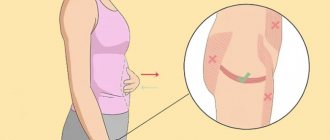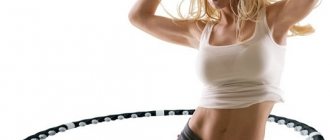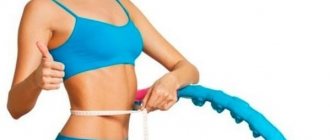On average, you can burn about 165 calories in a 30-minute session
If you think that hula hoop is a child's game, then you are mistaken. This simple piece of equipment will make your workouts more fun and your waistline slimmer.
When it comes to sports, finding something you really enjoy is key to making physical activity an enjoyable part of your day. When workouts are fun, you look forward to the next one, which means you will always be motivated to further develop.
In this article, we'll look at the benefits of hula hoop training, as well as steps to help you get started.
Benefits of Hula Hoop Training
Burns calories
Creating a calorie deficit is one of the main goals for losing weight. According to the Mayo Clinic, hula hoop training is comparable to other aerobic dance classes: salsa, swing and belly dancing.
On average, you can burn about 165 calories in a 30-minute session.
Removes extra centimeters
When you burn calories through exercise and make the right changes to your diet, you increase your chances of losing body fat. And according to a small 2015 study, if you're looking to lose a few inches from your waist and hips, a hula hoop may be your best choice, especially a weighted one.
A study in which 13 women trained with hula hoops for 6 weeks found that women lost an average of 3.4 centimeters in their waist and 1.4 cm in their hips.
Improves cardiovascular health
Cardiovascular (also known as aerobic) exercise works your heart and lungs and improves the flow of oxygen throughout your body. This, in turn, can reduce the risk of heart disease and diabetes, normalize cholesterol levels, improve brain function and even reduce stress.
Engages the core muscles
If you've tried hula hooping before, you know how intensely you have to move your hips.
To keep the hoop moving, you need a strong core (external obliques) and good hip mobility. Learning how to use a hula hoop and using it regularly is a great way to train your abdominal muscles, as well as your obliques and hip muscles.
Improves balance
Good balance helps you better control your body movements. It also helps improve your posture and allows you to perform other exercises correctly.
According to the American Council on Exercise, any type of physical activity that requires you to maintain posture and stability, such as hula hoops, can help you maintain and improve your balance.
Engages the muscles of the lower body
Hooping trains more than just your core muscles. Lower body muscles, including your quadriceps (front of your thighs), hamstrings (back of your thighs), glutes, and calves will also feel a burning sensation, especially if you're using a weighted hoop.
The whole family can exercise
It's difficult to find time for sports when you have a family. After work, study, caring for children and cleaning the house, there is practically no time and energy left for training.
Hula hoop is one way to exercise and spend time with your family at the same time. Children, spouse and even your parents can join you outdoors or at home. This fun fitness routine will help you bond and enjoy your time together.
Inexpensive and portable form of physical activity
Hula hoop doesn't involve going to a gym, exercising in a crowded gym, or waiting in line for a cardio machine. Plus, it's inexpensive and you can practice almost anywhere, including your living room, front yard, or garage.
The cost of a standard hoop varies from 200 to 400 hryvnia, and a weighted hoop will cost you about 500-1250 hryvnia, depending on the brand.
Rules for performing exercises
Remember: you cannot spin the hula hoop after a hearty lunch or on an empty stomach. The ideal option is to perform exercises 60 minutes after eating. If you intend to make your waist thinner and your stomach flat, rotate your hula hoop and place your feet together. If you want to reduce the volume of your hips, your feet should be shoulder-width apart.
You will be able to lose weight with the help of the “Make Your Waist” hoop if your workouts become daily. It is advisable to practice for half an hour a day. You can do less, but regularly. It is important not to give up physical exercise when the desired result has already been achieved. Otherwise you will have to start over.
And one moment. You won't be able to get a slim waist through exercise alone. You need to reconsider your diet. Eliminate or reduce consumption of sweet, starchy and fatty foods.
Where to begin?
All you need to get started is a hoop and some free space. Here are some tips for beginners:
- Find the right size hoop. The success of your training largely depends on the hoop size you choose. One tip for beginners is to use a larger hoop to start with slow spins. If possible, try spinning the hoop before you buy it.
- Choose the appropriate weight. If you are choosing a weighted hoop, a good rule for beginners is to start with a hoop that weighs 0.5-1 kg. As you get stronger, move up to heavier hula hoops, but only if you can maintain proper posture.
- Watch training videos. You can easily find many online tutorials that explain how to spin a hula hoop correctly.
- Start with shorter workouts. Start with two or three 10-minute sessions per day. Then, gradually add time to each workout.
Which hula hoop to choose?
I immediately remembered an anecdote: yesterday I bought a hula hoop for my wife, she tried it on - it was just right for her.
The sports market now has a large selection of a wide variety of hula hoops, both regular and weighted, there are massage hoops and even folding hoops so that you can take them with you on the road.
You don’t have to bother buying a hula hoop at a sports store, but improve an ordinary hoop by making it heavier by filling it with fine river sand through a small hole. In this case, training will be much more effective in terms of burning fat and your waist will quickly become thinner.
How to properly train with a hula hoop?
To properly train with a hula hoop, be sure to follow these steps:
- First, make sure your feet are positioned correctly. Place them slightly wider than shoulder width. One leg should protrude slightly forward.
- Next, make sure your back is straight and your core is engaged. Avoid bending at the waist and straining your lower back.
- Place the hoop on your waist with emphasis on your back, grab it from both sides.
- Start rotating the hoop counterclockwise. If you are left-handed, you may find it easier to rotate it clockwise.
- As the hoop begins to rotate, move your waist in a circular motion to keep the hoop moving. Move your hips forward slightly as the hoop moves across your stomach, and move your hips back slightly as the hoop moves to your back.
- Don't worry about the hoop falling. This is fine. Just pick it up and keep trying until you get used to the movement.
VARIETIES OF HOOP AND THE RIGHT CHOICE
The height of the projectile is selected along the lower border of the ribs. The simplest and cheapest version of the hoop is plastic. An aluminum hoop is more durable and heavier. The most expensive is rubber. The most famous manufacturers of hoops are: Health Hoop, which produces collapsible models with devices in the form of massage elements. Make a Body is a manufacturer of simple, one-piece hula hoops. Types of hula hoop:
- Simple. It has a void inside and is made of iron or plastic. This type of hoop only helps to keep muscles toned, but is not suitable for losing weight at the waist.
- Folding. Convenient, saves space by folding in half or four.
- Weighted. Provides intense massage of the waist and hips due to the increased weight of one to two kilograms. Very effective for weight loss.
- Massage. Special metal or plastic protrusions, spikes or ribs help you lose weight. It copes well with extra centimeters in the waist and back area, but at first you will have to come to terms with the possible appearance of bruises. Often equipped with a mini-computer. This allows you to monitor the duration of the lesson, the number of revolutions of the hoop, take into account calorie losses and changes in waist size.
- Flexible. Created not only for weight loss, but also for developing the muscles of the arms, back and legs.
Safety Tips
While this type of training is relatively safe, there are a few tips to keep in mind:
- Watch your posture. Keep your spine straight and your core tense.
- Wear tight-fitting clothing. Wear clothes that hug your body, such as yoga pants or cycling shorts and a fitted top. The fabric should not interfere with the movement of the hula hoop.
- Proceed with caution if you have a back injury. If you have a back injury or chronic back pain, check with your doctor or physical therapist before hula hoops to make sure it's safe for you.
Source: hochu.ua
Is a hoop harmful?
If the movements are performed correctly, for a healthy person, twisting a hoop does not cause any harm, but only benefit. Only small hematomas are possible at first, which then quickly disappear and do not appear again. But still, you should not hula hoop: pregnant women, immediately after childbirth, people with kidney, liver, ovarian diseases, as well as those with previous injuries to the back, legs, neck, so before starting classes, consult a doctor.
Types of projectiles
How many varieties are there of hula hoops? Some of them are made of plastic, others are made of special rubber. In addition, shells differ in their design characteristics.
Currently, you can purchase the following types of hula hoops:

- Weighted. Such products are made of plastic and are hollow inside, which allows the use of special fillers to weigh down sports equipment. A heavy hoop allows you to increase the intensity of the load, which speeds up the process of losing weight;
- Elastic. Made from plastic materials, this allows you to use sports equipment not only for its intended purpose, but also as an expander for training various muscle groups;
- Prefabricated. If necessary, such a projectile can be disassembled into several parts, which greatly simplifies its transportation and storage;
- Roller. On the inside of such a device, instead of spikes, there are special rollers that massage problem areas, thereby improving blood circulation and increasing muscle tone.
The benefits of hula hoop spinning
The massage hoop significantly improves muscle tone, which over time will have a positive effect on the shape of the waist.
In addition, regular exercise with sports equipment will allow you to:
- Develop the vestibular apparatus;
- Significantly improve posture when walking;
- Tighten and strengthen the muscles of the thighs, abs, and back;
- Get rid of cellulite and sagging skin;
- Improve blood circulation;
- Strengthen the cardiovascular system.
However, it is worth considering that the benefits of twisting a spiked hoop are possible only with the correct technique for performing various exercises.
That is why, before you start training, you should familiarize yourself with the rules for using this equipment.
Interesting fact

Many people mistakenly believe that spiked hoops for effective weight loss do not promote weight loss. However, experts say that in just 100 minutes of torsion, you can lose from 1000 to 1200 calories.
An athlete loses approximately the same amount during a 30-minute intense workout in the gym. In this case, approximately 0.6 mm of volume is removed from the waist, which allows you to get rid of 2-3 cm of volume in the abdominal area in just one week of training.
A gymnastic hoop is an excellent device that allows you to get rid of a couple of extra pounds without much effort, and even at home.
Thanks to such sports equipment, you can not only get your body in order, but also improve the condition of your skin and get rid of cellulite.
CONTRAINDICATIONS
Doctors warn against training with a hoop during menstruation, during pregnancy and for two months after it. The use of the hula hoop is not recommended for older people and those with diseases of the back, kidneys, abdominal cavity and gynecological problems. You should not exercise before bed.
Rotation of a hoop is an excellent workout for the waist, while engaging the muscles of the buttocks, back and legs. To achieve maximum benefits from exercise, you need to maintain a proper diet and increase overall physical activity.











